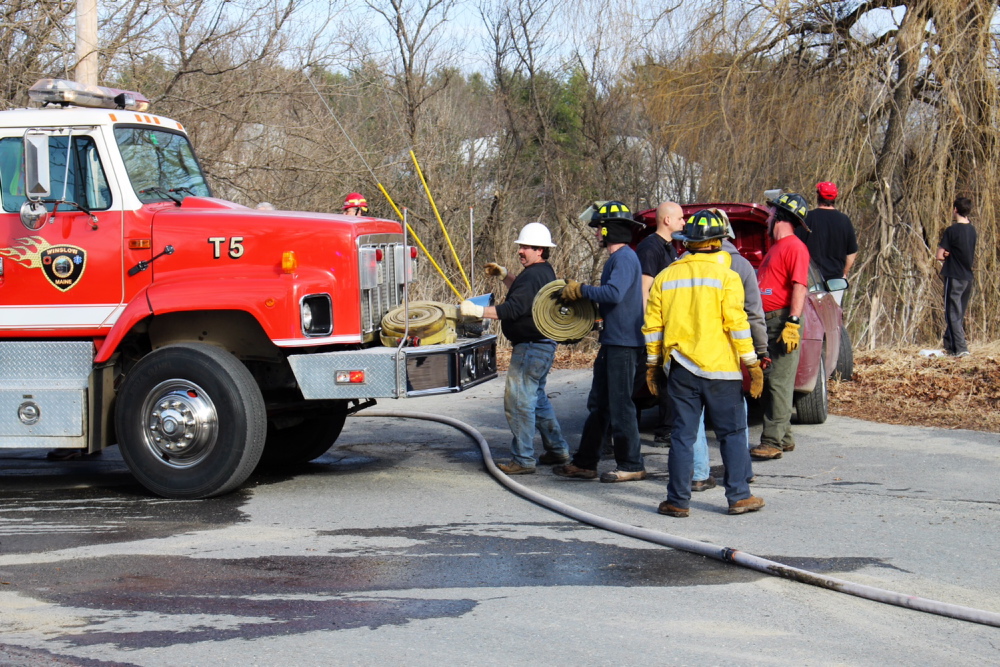The wildfire danger is high for inland areas in Maine ranging from York County to Piscataquis County because of dry brush, low humidity and windy conditions, according to the Maine Forest Service.
The Maine Forest Service responded to nearly a dozen spot fires in the southern part of the state over the weekend, according to David Hilton, a dispatcher for the forest service. About a half-dozen brush fire reports were logged in area police reports.
On Sunday, a small campfire started by two 18-year-old men in Winslow off Dallaire Street near the Sebasticook River started to spread up a hill, according to Waterville Fire Lt. Scott Holst. Fire personnel from Winslow and Waterville were able to quell the blaze before it spread much farther, according to Holst.
The bundle of spot fires this weekend isn’t surprising to the forest service, which said fires are down to date so far this year, mostly because of the late start to spring, yet the danger is at some of the highest levels of the year.
“Everything out there is essentially kindling,” Hilton said. “Things aren’t that green out there yet.”
Dry brush, along with little humidity and windy conditions can lead to elevated fire danger. With nearly all snow melted, last year’s dead grass now has the opportunity to ignite, according to Kent Nelson, a forest ranger specialist for the Maine Forest Service
“This is the time of year before things start greening up,” Nelson said. “The dead grass from last year that has been matted down by the snow can now blow around in the dry, warm wind. This is the time of year with the lowest relative humidity.”
Parts of York, Cumberland, Oxford, Androscoggin, Franklin, Kennebec, Somerset and Waldo counties are classified as high for predicted fire danger, according to the forest service. A high rating describes a time when fires can start easily from most causes and unattended brush and campfires are likely to escape and spread rapidly. In a high-rating area, fires can become serious and difficult to control unless they are spotted and put out quickly.
When an area is considered a class 3 high fire danger, the state doesn’t issue burn permits at its statewide permit website, according to Nelson.
“The reason for that is so people avoid burning during the most dangerous time of the year,” Nelson said.
Still, residents can apply for burn permits through local fire departments, many of which rely on the same system as the state to issue them. Some larger communities with bigger departments, however, such as the Waterville Fire Department, use their own discretion when issuing burn permits when its region is rated high for fire danger.
“We use our own judgment and check what the wind conditions are like and what they’re going to be,” Holst said. “We had about a dozen calls for burn permits over the weekend, but we only issued about three or four, and we had to turn around and cancel them later that day.”
A couple brush fires were approved Tuesday morning, Holst said, and were out by early afternoon. About 2 p.m., Holst said it was unlikely that another permit would be issued for the day.
With a late spring this year, the dangers of spring fires is a little behind schedule, Nelson said, but there’s a larger-than-usual amount of debris in residents’ backyards from the December ice storm that tore down limbs and branches. So far, the forest service has dealt with about 30 fires south of Newport, about half of the amount this time last year. Some of that can be attributed to the cold, wet temperatures that crept into March.
Yet an anxiousness to clean up from the winter’s damage can lead people hoping to burn off their brush to do so before it’s safe, Nelson said. A major cause of spring fires, according to Hilton, is debris or brush pile burning. The brush is typically dry and fires can spread more easily.
To prepare better for fire conditions, Nelson said, the forest service is working this year to increase the geographical zones separating the state from seven areas to 12.
“If you look at the map, weather zone three is a large area,” Nelson said. “We’re working to expand the zones to 12 with the idea of more tailoring it more specifically to areas.”
Jesse Scardina — 861-9239 jscardina@centralmaine.com Twitter: @jessescardina
Send questions/comments to the editors.




